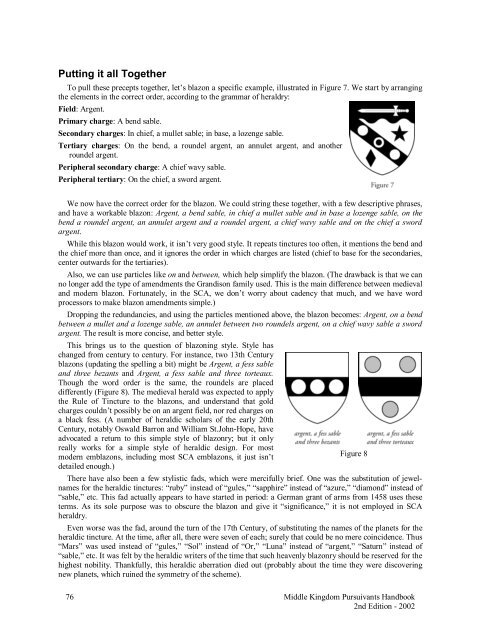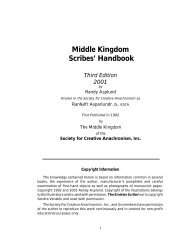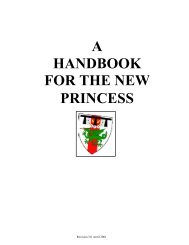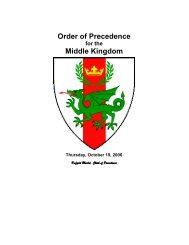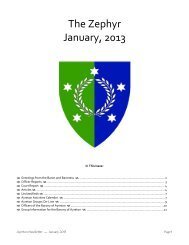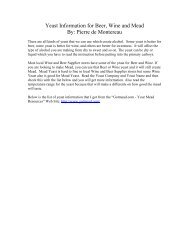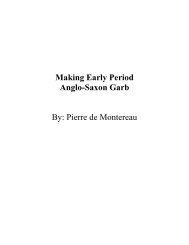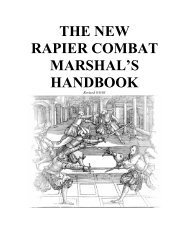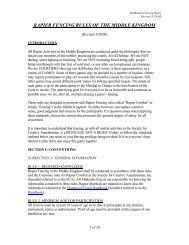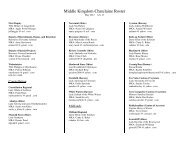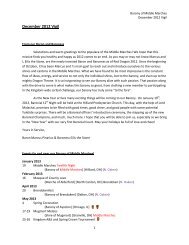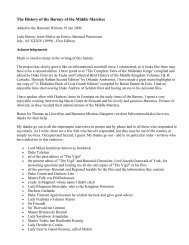Putting it all TogetherTo pull these precepts together, let’s blazon a specific example, illustrated in Figure 7. We start by arrangingthe elements in the correct order, according to the grammar of heraldry:Field: Argent.Primary charge: A bend sable.Secondary charges: In chief, a mullet sable; in base, a lozenge sable.Tertiary charges: On the bend, a roundel argent, an annulet argent, and anotherroundel argent.Peripheral secondary charge: A chief wavy sable.Peripheral tertiary: On the chief, a sword argent.We now have the correct order for the blazon. We could string these together, with a few descriptive phrases,and have a workable blazon: Argent, a bend sable, in chief a mullet sable and in base a lozenge sable, on thebend a roundel argent, an annulet argent and a roundel argent, a chief wavy sable and on the chief a swordargent.While this blazon would work, it isn’t very good style. It repeats tinctures too often, it mentions the bend andthe chief more than once, and it ignores the order in which charges are listed (chief to base for the secondaries,center outwards for the tertiaries).Also, we can use particles like on and between, which help simplify the blazon. (The drawback is that we canno longer add the type of amendments the Grandison family used. This is the main difference between medievaland modern blazon. Fortunately, in the SCA, we don’t worry about cadency that much, and we have wordprocessors to make blazon amendments simple.)Dropping the redundancies, and using the particles mentioned above, the blazon becomes: Argent, on a bendbetween a mullet and a lozenge sable, an annulet between two roundels argent, on a chief wavy sable a swordargent. The result is more concise, and better style.This brings us to the question of blazoning style. Style haschanged from century to century. For instance, two 13th Centuryblazons (updating the spelling a bit) might be Argent, a fess sableand three bezants and Argent, a fess sable and three torteaux.Though the word order is the same, the roundels are placeddifferently (Figure 8). The medieval herald was expected to applythe Rule of Tincture to the blazons, and understand that goldcharges couldn’t possibly be on an argent field, nor red charges ona black fess. (A number of heraldic scholars of the early 20thCentury, notably Oswald Barron and William St.John-Hope, haveadvocated a return to this simple style of blazonry; but it onlyreally works for a simple style of heraldic design. For mostmodern emblazons, including most SCA emblazons, it just isn’tFigure 8detailed enough.)There have also been a few stylistic fads, which were mercifully brief. One was the substitution of jewelnamesfor the heraldic tinctures: “ruby” instead of “gules,” “sapphire” instead of “azure,” “diamond” instead of“sable,” etc. This fad actually appears to have started in period: a German grant of arms from 1458 uses theseterms. As its sole purpose was to obscure the blazon and give it “significance,” it is not employed in SCAheraldry.Even worse was the fad, around the turn of the 17th Century, of substituting the names of the planets for theheraldic tincture. At the time, after all, there were seven of each; surely that could be no mere coincidence. Thus“Mars” was used instead of “gules,” “Sol” instead of “Or,” “Luna” instead of “argent,” “Saturn” instead of“sable,” etc. It was felt by the heraldic writers of the time that such heavenly blazonry should be reserved for thehighest nobility. Thankfully, this heraldic aberration died out (probably about the time they were discoveringnew planets, which ruined the symmetry of the scheme).76 <strong>Middle</strong> <strong>Kingdom</strong> <strong>Pursuivants</strong> <strong>Handbook</strong><strong>2nd</strong> <strong>Edition</strong> - 2002
Still found in mundane blazons are conventions left over from Victorian times. Those blazoners tried to avoidthe appearance of tautology, but at the expense of clarity and succinctness. Thus, instead of repeating a tincture,they would use such phrases as “of the field” or “of the third,” the latter referring to the third tincture alreadymentioned. Similar phrases might refer to number or type of charge. Thus a device we might blazon as Argent,on a fess sable between three mullets gules, three annulets argent, a chief gules would be blazoned in aVictorian style as Argent, on a fess sable between three mullets gules, as many annulets of the field, a chief ofthe third. Such profusion of types and tinctures yield a complex blazon even under the best of circumstances;it’s silly to further complicate the blazon with reference that require the blazoner to keep count of the tincturesas they are mentioned.The blazoning style of the SCA College of Arms depends, for the most part, on whoever happens to beLaurel. This is not mere cynicism, but a statement of fact. The same is true, after all, in the English College ofArms. J.P. Brooke-Little, in one of the footnotes to his edition of Fox-Davies’ Complete Guide to Heraldry,sums up the situation nicely:“What really constitutes official blazon? Quite simply, it is the minds of the granting Kings of Arms. It isthey who blazon arms and who must take responsibility for good or bad blazon. The rest of us can write aboutwhat has been done in the past and what we think ought to have been done, but our opinions are chaff before thewind unless we can persuade the King of Arms of the day to adopt our ideas.”In general, the SCA tends to a simpler style of blazon. We avoid obvious Victorianisms; we do not hesitate torepeat a tincture or a number. The idea is to make ourselves understood, not obscure. A few other peculiaritiesof our system:• The tincture “Or” (gold) is always capitalized in SCA blazon, to avoid confusion with the grammaticalconjunction. (Modern mundane blazons go even further, and capitalize all the tinctures.)• The tincture “ermines” (black with white ermine spots) is blazoned “counter-ermine” in SCA blazonry.This is the translation of the French blazon, and is used to avoid possible typographic error.• Following medieval practice, the diminutive terms for the ordinaries (“bendlet,” “bar,” etc.) do not meanthe ordinary is to be “drawn skinny.” Instead, such terms are used when there are more than one of theordinary (three bars) or when the visual importance is reduced (a bendlet enhanced). The width of thestripes does not affect the blazon: one horizontal stripe is always a fess, and three of them are blazonedthree bars, no matter how wide or skinny they happen to be.• The engrailed line of partition, when applied to the field, does not seem to follow themundane default; the references disagree on exactly what that mundane default is. InSCA blazon, Per fess engrailed has its points to chief (Figure 9); similar defaults holdfor Per bend engrailed, Per chevron engrailed, etc. Invected lines have their points tobase by SCA default.• SCA blazonry uses “inverted” to describe a charge turned upside-down, and “reversed”for a charge turned to face sinister. (Mundane blazonry uses “reversed” in the way weuse “inverted.” I don’t know how the SCA system originated.) “Contourny” and“turned to sinister” may also be used in lieu of “reversed,” if one wishes to avoid theconfusion.Our goal is not just to blazon, but to blazon well. The essence of good blazon style is threefold:1. The blazon must be accurate. All necessary details should be blazoned. The type of charge, its posture, itstincture—anything, if not the default, that counts for heraldic difference must be specified.2. The blazon must be unambiguous, unequivocal. The purpose of the blazon, after all, is to make possiblethe reconstruction of the emblazon. Ideally, a blazon should be capable of only one interpretation. A blazonthat may be interpreted in more than one way is fatally flawed.Some emblazons may be blazoned in more than one way: A griffin segreant is the same as a griffin rampant,and one may have three bendlets sinister or three scarpes with equal ease. Such choices are usuallygoverned by the submitter’s preference, or that of the submitting herald. In other cases, a distinction can bemade worth no heraldic difference, but which influences the heraldic artist: a shamrock vs. a trefoil, or anacorn slipped and leaved vs. an oak slip fructed. One must gauge from the submitter’s intent.<strong>Middle</strong> <strong>Kingdom</strong> <strong>Pursuivants</strong> <strong>Handbook</strong> 77<strong>2nd</strong> <strong>Edition</strong> - 2002
- Page 2:
Middle Kingdom Pursuivants Handbook
- Page 5 and 6:
INTRODUCTION.......................
- Page 7 and 8:
Saracens: Early to Mid-Medieval Mus
- Page 9 and 10:
IntroductionOsric of FayrehopeWhat
- Page 11 and 12:
AcknowledgementsMistress Elena de V
- Page 13 and 14:
The Middle KingdomCollege of Herald
- Page 15 and 16:
Regional HeraldsConstellation Heral
- Page 17 and 18:
Pursuivant DutiesDuties of the Bran
- Page 19 and 20:
All submissions should be sent to t
- Page 21 and 22:
What to Report?First of all, your r
- Page 23 and 24:
esponsibility now. It wouldn’t hu
- Page 25 and 26:
simply too pervasive. Chilly weathe
- Page 27 and 28:
switched into the losers’ bracket
- Page 29 and 30:
prevent accusations of a rigged lis
- Page 31 and 32:
the green fabric), a larger spool o
- Page 33 and 34:
Precedence and CourtesyCourtly Beha
- Page 35 and 36:
Territorial Barons and Baronesses m
- Page 37 and 38: c. Once all presentations appear to
- Page 39 and 40: i. Oaths of Fealty and Acknowledgem
- Page 41 and 42: herald is the voice of the Crown an
- Page 43 and 44: Award of the Dragon's FlightOP Abbr
- Page 45 and 46: Award of ArmsOP Abbreviation - AoAL
- Page 47 and 48: Order of the Red CompanyOP Abbrevia
- Page 49 and 50: Order of the WillowOP Abbreviation
- Page 51 and 52: Order of the Gold MaceOP Abbreviati
- Page 53 and 54: Master of ArmsOP Abbreviation - MSC
- Page 55 and 56: Prince and Princess of NorthshieldO
- Page 57 and 58: - The Consort of Northshield bears
- Page 59 and 60: The Submission ProcessWorking with
- Page 61 and 62: A good consultant will have these e
- Page 63 and 64: submit it anyway (“I may be wrong
- Page 65 and 66: Internal Letter Of Acceptance And R
- Page 67 and 68: NamesOn Names and Name Documentatio
- Page 69 and 70: Choosing a CultureJehan de la March
- Page 71 and 72: Clothing: For the Slavic groups, pr
- Page 73 and 74: Politics: The entire Islamic world
- Page 75 and 76: Although in the earlier Middle Ages
- Page 77 and 78: character in Household’s Arabesqu
- Page 79 and 80: An Extremely Brief BibliographyWest
- Page 81 and 82: ArmoryThe Philosophical Roots of He
- Page 83 and 84: Even if your natural instinct for a
- Page 85 and 86: 5. Peripheral secondary charges.6.
- Page 87: Brisures (marks of cadency) and aug
- Page 91 and 92: Efficient Conflict ResearchKeridwen
- Page 93 and 94: 1. Is there a peripheral charge (a
- Page 95 and 96: checking under the old rules, the s
- Page 97 and 98: 2. Yes, the peripheral is charged.
- Page 99 and 100: Many authors state that dancetty is
- Page 101 and 102: Charges may be placed on either sid
- Page 103 and 104: It’s a bit more complicated to ke
- Page 105 and 106: This page shows properly drawn exam
- Page 107 and 108: This page shows a number of common
- Page 109 and 110: Postures of Animals (cont’d)Posit
- Page 111 and 112: Postures of BirdsPosition & Comment
- Page 113 and 114: Postures of Fish and DolphinsPositi
- Page 115 and 116: Barony of Caer Anterth MawrAzure, a
- Page 117 and 118: Barony of the North WoodsAzure, a w
- Page 119 and 120: Shire of AfonlynAzure, on a bend ar
- Page 121 and 122: Shire of Rivenwood TowerErmine, on
- Page 123 and 124: Reference BooksThe Basic HeraldBron
- Page 125 and 126: Bardsley, Charles Wareing. English
- Page 127 and 128: Kaganoff, Benzion C. A Dictionary o
- Page 129 and 130: Sims, Clifford Stanley. The Origin
- Page 131 and 132: Moncreiffe, Iain, and Don Pottinger
- Page 133 and 134: Bruce Draconarius of Mistholme and
- Page 135 and 136: Rules and RegulationsRules for Subm
- Page 137 and 138: Although China, Random and Starhawk
- Page 139 and 140:
iii. Heraldic Titles - Heraldic tit
- Page 141 and 142:
ii. Number of Name Phrases - A pers
- Page 143 and 144:
PART VII - COMPATIBLE ARMORIAL CONT
- Page 145 and 146:
i. A metal and a color;ii. An eleme
- Page 147 and 148:
PART IX - OFFENSIVE ARMORYOffensive
- Page 149 and 150:
ii. Field-Primary Armory - If neith
- Page 151 and 152:
j. Changes to Charges on Charges -
- Page 153 and 154:
3. Marshalling. - Armory that appea
- Page 155 and 156:
directly by individuals, but may be
- Page 157 and 158:
the Laurel Office from the registra
- Page 159 and 160:
charge or augmentation is transferr
- Page 161 and 162:
so that ð is alphabetized as dh,
- Page 163 and 164:
1. Failure to Comment. Failure to c
- Page 165 and 166:
B. Content of Letters of Acceptance
- Page 167 and 168:
1. Principal Heralds - The Principa
- Page 169 and 170:
1. Financial Reports - Financial re
- Page 171 and 172:
Appendix B - Standard Designations
- Page 173 and 174:
Appendix D - Suggested Standard For
- Page 175 and 176:
Appendix G - Role of the Deputy Sov
- Page 177 and 178:
Glossary of TermsThis glossary was
- Page 179 and 180:
Complement, In Her*—Describes the
- Page 181 and 182:
Fur—Some furs, like Vair, Potent
- Page 183 and 184:
Mon—Japanese armorial insignia†
- Page 185 and 186:
Registration—Acceptance by Laurel
- Page 187 and 188:
AppendicesSources for Heraldic Publ
- Page 189 and 190:
• Send the four copies in and kee
- Page 191 and 192:
“Major” or “minor” changes?
- Page 193 and 194:
See the General section at the begi


